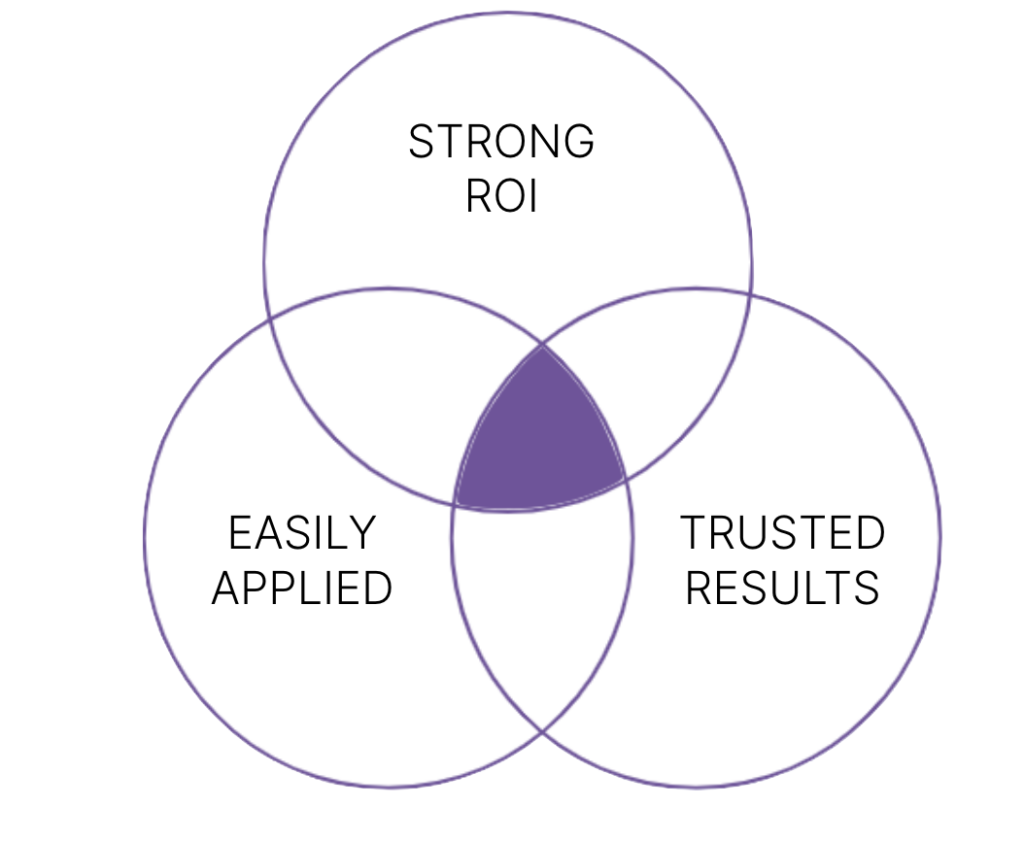

Are you on the correct side of the GPT divide?
Fad or future
Gartner’s Hype Cycle describes the trajectory of technologies, and I’m starting to see people claiming that AI/GPT is hype and we are over the hump, The Peak Of Inflated Expectations, and headed into the Trough of Disillusionment.

Whilst the hype cycle has been true for most technologies over the last 30 years, I have never seen any shift in my lifetime that matches GPT – and I’ve lived through color TV, PC/ laptops, the internet, and mobile. The naysayers have misjudged it. There are 3 factors that make this so very different:
- Speed of adoption: 100 million users in few short months
- The dramatic increases in ROI : massive productivity improvements in every area of business in every industry, which is increasing with every wave of innovation
- The pace of constant innovation: just as we climb to the Peak of Inflated Expectations and new innovation is launched and we back at the Innovation Trigger
The coming wave of generative AI will be more revolutionary than any technology innovation that’s come before in our lifetime, or maybe any lifetime. It is reshaping our world in ways that we’ve never imagined. This AI revolution is just getting started.
Marc Benioff (in 2023)
No silver bullet but a sweet spot
Just over a year ago, GPT was virtually unknown to many. Since then, its potential applications have multiplied. In the past quarter alone, GPT’s capabilities have surged, making certain tasks up to 1000x quicker, but also with increased accuracy. This seems to be at odds with the concerns of toxicity and hallucinations.
Too many people view tools like ChatGPT, as more powerful search engines, expecting them to deliver precise information about the world. Unfortunately, with all the inherent biases and inaccuracies in the data, this approach is flawed, leading to errors and misinformation. And claims that GPT is hype.
What GPT really excels at, is solving complex problems, when given the right inputs. Its ability to comprehend natural language, reason, analyze data, and communicate in an equally natural manner, is remarkable. Instead of using GPT tools like Google on steroids, we should be thinking of GPT as a super-efficient intern. An intern that when properly directed, can produce impressive results from the get-go. However, the quality of these results directly correlates to the level of detail in the instructions given: these instructions comprise prompts and context.
The greatest successes are where the tasks are very specialized, and where you are using GPT’s “puzzle solving” capabilities, rather than relying on knowledge of the internet to drive the results; called RAG or grounding. This is where your prompts use GPT to provide answers based on the dataset that you have provided. This is extremely effective, but as we have said it is on narrowly scope tasks.
The way to identify these tasks is to consider the AI Sweet Spot. It is the intersection of:
- Strong ROI: tangible repeatable benefits
- Easily applied: the data, prompts, and approach are able to be relatively easily created and applied to the business process
- Trusted results: the output doesn’t have to 100% correct 100% of the time, but it is reliable and repeatable enough that it can be trusted.

Just some of the examples we are seeing:
- Writing code Drawing process maps from transcripts
- Analysis of legal documents
- Summarization of video content
- Pricing deals
At the moment these tasks are quite specialized and AI isn’t going to replace human jobs. It’s an aid to enhance productivity. In the future, AI will undoubtedly revolutionize industries, companies, and employment. A quote that I came across recently summarizes this: “AI won’t take your job, but someone using AI will.”
Why is corporate technology adoption so slow?
Although corporate adoption of AI/GPT is fairly slow, there is a real fear of falling behind others and missing a competitive advantage. This is demonstrated in Cisco’s AI Readiness survey, which polled over 8,000 IT leaders. The survey revealed that 97% of IT leaders believe there’s an increased urgency to adopt AI-powered technologies. Additionally, Salesforce’s Generative AI Snapshot Research Series, surveying over 4,000 professionals, indicated that 86% of IT leaders foresee a significant role for generative AI in their organizations.
But the genuine concerns about GPT are holding them back. That very Salesforce survey, highlighted that 65% of participants, were yet to justify the implementation of generative AI. According to Salesforce’s Generative AI Snapshot Research Series, implementation of generative AI, had been put on the backburner, due to:
- concerns of security threats – reported by 71% of participants
- the widening of a skills gap amongst employees – reported by 66% of participants
- the absence of a unified data strategy – reported by 59% of participants.
- integration challenges – reported by 60% of participants
It’s also fairly common for organizations to resist introducing innovative technology, until market leaders emerge. The thought behind this is to mitigate any risks that may arise through adopting the wrong technology. These organizations represent the Early Majority in Geoffrey Moore’s classic buyer bell curve; described in his book “Crossing the Chasm.” Organizations and specific employees, that actively experiment with GPT, would be classified as ‘Early Adopters’ instead.

Again, I think that GPT is breaking some of these norms. The pace of innovation and the ability to apply GPT to such a broad scope of tasks means that organizations cannot afford to sit back and wait. I believe that they need to get engaged so that they understand how, where, and how much they can apply GPT.
Some organizations are already getting staggering benefits. But they are also learning how to dovetail GPT into their organizations. That positions them perfectly as the next wave of innovation hits. In the past innovation has been at a slow pace, in clearly defined areas, and therefore success stories emerged and the Early Majority could learn from the Early Adopters. For example: Customer Success Management or CRM. That is not true with the current waves of GPT.
There appears to be a multiplier effect. Early adoption of GPT generates an understanding of what is possible today, but then helps identify even more powerful use cases building on previous experiences and so on. It is a virtuous spiral of innovation – experiment > adopt > operationalize > experiment.
That is why I believe every organization needs to identify their employees who are the most innovative and passionate around GPT – the early adopters. They need to support them as they experiment – and at times fail. To manage the risk their activities need to be ring-fenced so that they don’t need tight regulatory controls because this will kill any innovation.
Employees vs organizations
Whilst adoption in organizations is low, StealthGPT or ShadowGPT is alive and well. Surveys show that employees, without their organizations’ blessings, are using GPT. They recognize its ROI, and are bypassing these restrictions. Discrete, unsanctioned use of these tools is obviously risky, raising security and compliance concerns. But imposing a blanket ban on AI use within organizations should be avoided.
As the former CIO of a major UK Government Agency, I recall that initially Salesforce and the concept of “cloud computing,” were met with skepticism., I was then CEO of a tech company. Having assessed the associated risks, we became early adopters of Salesforce, because we saw the benefits of cloud computing. We also saw the risks and we put controls in place to mitigate them. I see attitudes towards AI, on the same trajectory, albeit at 10 or 100x the pace.
I wrote an article back in 2007 about Stealth Cloud and how to approach it. The acronym PASTA sets out the actions:
- Policy: get policies in place as quickly as possible to provide guardrails, and accept that these may change as you learn more
- Amnesty: Encourage employees to share what they are doing and which technologies they are using – without fear that it will be shut down or they will be penalized. This will identify the best use cases.
- Support: Provide IT support for the technologies they are using. Again, you cannot shut them down (yet)
- Technology Evaluations: In parallel do the due diligence on the technologies, so that you can select those that support the use cases and that you want to roll out globally
- Adoption: Implement the new technologies and then help migrate from the current technologies and then work to drive up adoption.
I simply took that 2007 article and did a global replacement of “GPT” for “cloud” and made a few tweaks. But you get the point. The principles and approach will work.
Leading by bleeding
It is not a surprise that Elements.cloud has been on the bleeding edge of GPT since late 2022. We’ve embedded it into our Change Intelligence Platform and it is driving staggering results. It has given us clear blue water between us and any competitors. We’ve been fortunate that our Change Intelligence Platform has a broad enough set of data and use cases where GPT can really shine.
What was interesting was that one use case – auto-generating process diagrams – we had tried to develop 4 years ago but the results were not good enough. We tried again 6 months ago. Again. Still not good enough. But now GPT is awesome. The ability to take any transcript and create very good process maps that accurately follow the UPN format is an amazing game-changer. And this is just one of many use cases already delivered in ElementsGPT.
Along the way, we did have wasted tech debt. We developed semantic databases and complex queries to get around the token limits of the early versions of GPT. And whilst the token limits mean some of these are no longer used, what we learned has meant the foundations of our GPT offering are far more robust. We’ve been at this for nearly 15 months. If some started just after Dreamforce last year, we have 3x as much experience. And that experience compounds.
ElementsGPT is available for customers and consultants as an add-on. Talk to one of our team to get your Space or consulting licenses set up with ElementsGPT.
The GPT Divide
I see a GPT divide forming. On one side there are organizations like Elements.cloud who are early adopters – we are learning, gaining experience and already getting benefits. On the other side, some organizations are scared of the risks – trust, security, data quality. And, they are also worried about GPT disrupting their industry, But, instead of making this a call to action they are using it as evidence to pull back and wait.
Mark Cuban, a billionaire investor, was recently interviewed by CNBC. He had some stark news.
There’s only two types of company in this world. Those that are great at AI and everybody else.
Mark Cuban. CNBC interveiw 54 March 2024
Organizations that discourage AI/GPT pilots, until the technology matures, are subject to the following issues:
- Stealth GPT or ShadowGPT – outright banning, encourages individuals to experiment with GPT covertly, with the appeal of its ROI being too strong to ignore. This opens the organization to risks they cannot see, so they cannot plan for.
- Innovation Brain Drain: invaluable employees who can contribute massively to innovation, may leave if they feel the potential of GPT is being overlooked and they are not permitted to take advantage of this rare opportunity.
- Competitive advantage: Organizations that are embracing GPT are already gaining a huge advantage, having accelerated innovation and boosted productivity, compared to competitors. But they are building this virtuous cycle of innovation.
Leaders in every organization should endorse the use of AI, even if only in limited, well-managed pilots. These projects should involve the most innovative individuals eager to leverage AI for their organization’s benefit. It’s crucial to establish safeguards to protect data security and trust. When market leaders have yet to become established, accepting that some technology choices might be premature is part of the process. Not every piloted application will succeed.
The final word
As a recent Harvard Business Review article stated, “Strategy, not technology, is key to succeeding with GenAI.” Executives can shape the trajectory of their organizations by actively engaging in AI initiatives. It’s about crafting a strategy that integrates AI into the business model thoughtfully and ethically. This strategic approach, rather than a mere fascination with the technology, will determine who thrives in this new landscape.
The Elements.cloud team have been working with AI for over 5 years and GPT for nearly 15 months. ElementsGPT is already delivering huge productivity gains around the change cycle, but there are so many other areas where we can do even more. Let’s chat about the many use cases already delivered by ElementsGPT today.
Sign up for
our newsletter
Subscribe to our newsletter to stay up-to-date with cutting-edge industry insights and timely product updates.

Ian Gotts
Founder & CEO10 minute read
Published: 8th March 2024






